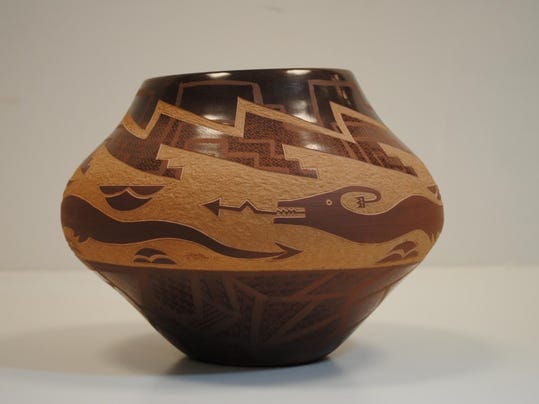By Bethany Youngblood
(Wikimedia commons)
(Meso-America is the economic name for the geographic area called Central America. It includes Mexico, Guatemala, El Savador, Honduras, Costa Rica, Nicaragua, Panama, and Belize). Here is a brief snapshot of who Avanyu was to his ancient worshippers, and how people explain this myth today.
The Water Serpent
The
name Avanyu, or Awanyu, literally means "water serpent" in the
language of the Tewa Indians.[1]
Avanyu was the deity of rain and lightning, of the river ways and water
sources. His symbolic representation is found on pottery as early as A. D. 1000[2] in
the form of a zigzagged horned and feathered serpent that shoots lightning from
his mouth.
Archaeologist
Polly Schaafsma, author of the essay "Quetzalcoatl and the Horned and
Feathered Serpent of the Southwest", has this to say about Avanyu:
“The horned serpent continues to be revered as an important deity among the Pueblos and is known by various names among the different linguistic groups, including Kolowisi (Zuni), Paaloloqangw (Hopi), and Awanyu (Tewa)..."[3]
If
these descriptions are sounding familiar, it is because there are many serpent
deities in ancient North and South America that share common traits.
In
our "Serpent Sanctuary" article we focused on the
serpent deities that were associated with fire, the heavens, and wisdom. But
there are just as many serpent deities that are associated more with water.
A Comparison
Earlier
we mentioned that Avanyu is often lumped together with the pagan Aztec deity
Quetzalcoatl. Both were “feathered serpents” that probably have their roots in
the counterfeits of Babel however, they have differences as well. According to
myth, Quetzalcoatl imparted wisdom to the people by appearing in the form of a
man whereas Avanyu and other serpent deities of North America did not. In
contrast the Pueblo serpent worshippers believed their deity was an actual
living creature that resided in the waters of the Rio Grande River, lurking in
underwater passageways.[4]
Is it
possible that the identity of Avanyu was bestowed on an actual creature living
at that time in ancient America? And that the reputation of the snake only
continued to grow and grow until it was legend? After all, the fearsome dragons of legend were most likely
based off of living dinosaurs of the time. The myths of Avanyu could be much
the same.
The Physical Avanyu
It
has been speculated that the physical form of the deity Avanyu was really based
on a real serpent that inhabited the waterways of the region at that time. The
snake could have been a relative of the anaconda in South America, or some
other sort of constrictor snake.[5]
The Titanoboa, for instance, is an extinct constrictor that could have measured
over 40ft in length![6]
This gives us a picture of how big these ancient snakes could have been and it
would be no surprise if the ancient people revered them.
As to
the “plumes” or “horns” said to characterize Avanyu, this is not too
far-fetched – in the Sahara there exists the Desert Horned Viper, which has two
very literal horns on its face.[7] It
is not impossible that a real creature inspired the stories of this pagan
god.
Another
theory presented by Peter Faris in his work on Native American Paleontology is
that fossils actually gave birth to
the idea of a horned water serpent. He suggests that discovery of mammoth
skulls or other horned animals in the proximity of rivers could have looked
like the remains of an underwater beast.[8]
We
may not know for sure what the ancient water serpent looked like, but modern
day Pueblo Indians believe the creature, worshiped in the past as Avanyu, is
still alive today.[9]
 |
| Avanyu still appears on Pueblo pottery today. Photo: Sonia W. and Victor J. Bauer http://www.dailyrecord.com/story/entertainment/arts/2014/04/11/preserving-pueblo-pottery/7511021/ |
Commonalities and Connections
The
more we study serpent deities the more commonalities appear to connect them
all. The same goes for many topics of the ancient world. This is no surprise
because we know that mankind once gathered together at Babel and shared one
goal and one purpose. Their common beliefs and interests are still discernable
today. The prominence of pagan serpent worship reminds us of the first two
people who were drawn away from the true God by a serpent in the Garden. Humanity
is fooled again and again as they continually reject God’s authority.
Keep looking
Maybe
this brief look at the pagan deity Avanyu also renewed an interest in the now
extinct, yet fantastic creatures that lived in the ancient world. Never stop
questioning and looking for answers! God’s creation is incredible and always
proclaiming His glory!
Have
you come across any commonalities in your own research? Let us know in the
comments or send us an email!
Learn more about ancient serpent deities:
- "Serpent Sanctuary" (An introduction to serpent deities)
- Snapshots: The Feathered Serpent
- Rumors of a "serpent cult" on the Ancient Island of Malta
[1] “Avanyu: Spirit of Water in Pueblo Life and Art”. Rosemary Diaz.
2014. Web. http://www.santafenewmexican.com/magazines/bienvenidos_2014/avanyu-spirit-of-water-in-pueblo-life-and-art/article_da0e9cb8-d4b2-11e3-9331-0017a43b2370.html
[2] Ibid.
[3] Ibid.
[4] “Awanyu.” Ryan
Roller-Kha-Po Owingeh. Web. http://en.m.wikipedia.org/wiki/Awanyu
[5] Ibid.
[6] “How Titanoboa the 40 foot long snake was found”. Guy Gugliotta.
Smithsonian Magazine. April 2012. Web. http://www.smithsonianmag.com/science-nature/how-titanoboa-the-40-foot-long-snake-was-found-115791429/
[7] “The Desert Horned Viper.” Jay Sharp. Web. http://www.desertusa.com/animals/horned_viper.html
[8] “Native American Paleontology”. Peter Faris. Web. http://www.slideshare.net/mobile/archeofaris/native-american-paleontology
[9]“Awanyu.” Ryan Roller-Kha-Po Owingeh. Web. http://en.m.wikipedia.org/wiki/Awanyu




Once I understood that ancient man saw what we call dinosaurs, I took a different look at all ancient art, and now I see dinosaur-like creatures often. Thanks for this article.
ReplyDeleteThat's great! Thanks for commenting! It's incredible what happens when you look at the same evidence/artifacts with a different perspective and a biblical lens.
Delete